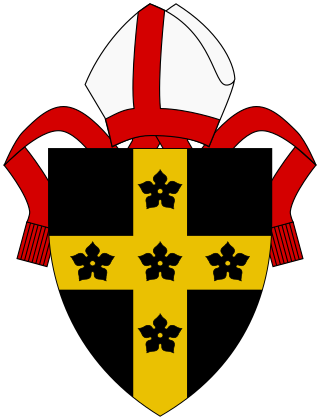Top Qs
Timeline
Chat
Perspective
Bishop of St Davids
Welsh bishop From Wikipedia, the free encyclopedia
Remove ads
The Bishop of St Davids is the ordinary of the Church in Wales Diocese of St Davids.
The succession of bishops stretches back to Saint David who in the 6th century established his seat in what is today the city of St Davids in Pembrokeshire, founding St Davids Cathedral. The most recent former bishop of St Davids was Joanna Penberthy,[1] who retired on 31 July 2023. On 17 October 2023, Dorrien Davies, Archdeacon of Carmarthen, was elected to become the next Bishop;[2] the confirmation of his election (where he legally became Bishop) happened on 29 November 2023 and his episcopal consecration took place on 27 January 2024 at Bangor Cathedral.[3]
Remove ads
History
Summarize
Perspective
The history of the diocese of St Davids is traditionally traced to that saint in the latter half of the 6th century. Records of the history of the diocese before Norman times are very fragmentary, however, consisting of a few chance references in old chronicles, such as 'Annales Cambriae' and 'Brut y Tywysogion' (Rolls Series).
Originally corresponding with the boundaries of Dyfed (Demetia), St Davids eventually comprised all the country south of the River Dyfi and west of the English border, with the exception of the greater part of Glamorganshire, in all some 3,500 square miles (9,100 km2).
Claim of metropolitan status
The early ecclesiastical organisation of the Welsh church is unclear but scanty references reveal that some form of archbishopric definitely existed, with multiple bishops under the jurisdiction of a senior see. One of the earliest mentions of the religious community at St Davids Cathedral comes in the work of Asser who was trained there. In his Life of King Alfred c. 893 Asser clearly describes his kinsman, Nobis, also of St Davids, as Archbishop. In the Annales Cambriae, Elfodd is termed 'archbishop of the land of Gwynedd’ in his obit, under the year 809.[4]
Rhygyfarch's Life of Saint David (c. 1090) states Saint David was anointed as an archbishop by the Patriarch of Jerusalem, a position confirmed at the Synod of Llanddewi Brefi by popular acclaim.
Then, blessed and extolled by the mouth of all, he is with the consent of all the bishops, kings, princes, nobles, and all grades of the whole Britannic race, made archbishop, and his monastery too is declared the metropolis of the whole country, so that whoever ruled it should be accounted archbishop.[5]
Rhygyfarch's claim may be dubious history, but there can be little doubt he was reflecting a pre-existing tradition. It is unclear when St Davids came definitely under the metropolitan jurisdiction of the Archbishop of Canterbury, but about 1115 King Henry I intruded a Norman into the see, Bernard, Bishop of St Davids, who prior to his ordination was confirmed by Canterbury, much to the disgust of the Brut y Tywysogyon which noted that Henry I 'made him bishop in Menevia in contempt of the clerics of the Britons’. Once in place Bernard became convinced that St Davids was a Metropolitan archbishopric (and thus of the same status as Canterbury). Bernard in the 1120s claimed metropolitan jurisdiction over Wales and presented his suit unsuccessfully before six successive popes. Pope Eugenius III was giving the case serious consideration, the issue was to be put to the synod summoned to meet at Rheims in March 1148, but the death of Bernard meant the case lapsed.[6] The idea of Archbishops in Wales was also reflected in the work of Geoffrey of Monmouth. The claim was afterwards revived in the time of Gerald of Wales who pressed it vigorously. The failure of Gerald's campaign saw the claim lapse but it was revived by Owain Glyndŵr's plan for an independent Welsh Church. The idea was also revived in the Reformation: Bishop Richard Davies in the 'Address to the Welsh nation' prefixed to the translation into Welsh of the New Testament by him and William Salesbury referred to 'Archbishop David'. It was only in 1920 that an Archbishop of Wales was re-established.
Remove ads
Further history
The building of the present St Davids Cathedral was begun under Bishop Peter de Leia (1176–1198). In the troubled times of the Reformation the former bishop of St Davids, William Barlow (1536–1548), was a consecrator of Archbishop Matthew Parker in 1559.
At the English Reformation the See ceased to be in communion with Rome, but it continued as a See of the Church of England, and, since disestablishment, of the Church in Wales.
Remove ads
List of bishops
Summarize
Perspective
Pre-Reformation bishops
Accounts of the early incumbents on the list are conflicting.
Nominal archbishops
Suffragan bishops
Bishops during the Reformation
Post-Reformation bishops
Bishops of the Church of England
Bishops of the disestablished Church in Wales
Remove ads
Assistant bishops
Prior to serving as Bishop diocesan, Ivor Rees was appointed Assistant Bishop of St Davids and Archdeacon of St Davids in 1988, in order to assist Noakes, by then both diocesan Bishop of St Davids and Archbishop of Wales.[23] Rees was elected diocesan bishop after Noakes' retirement.
References
Wikiwand - on
Seamless Wikipedia browsing. On steroids.
Remove ads

























